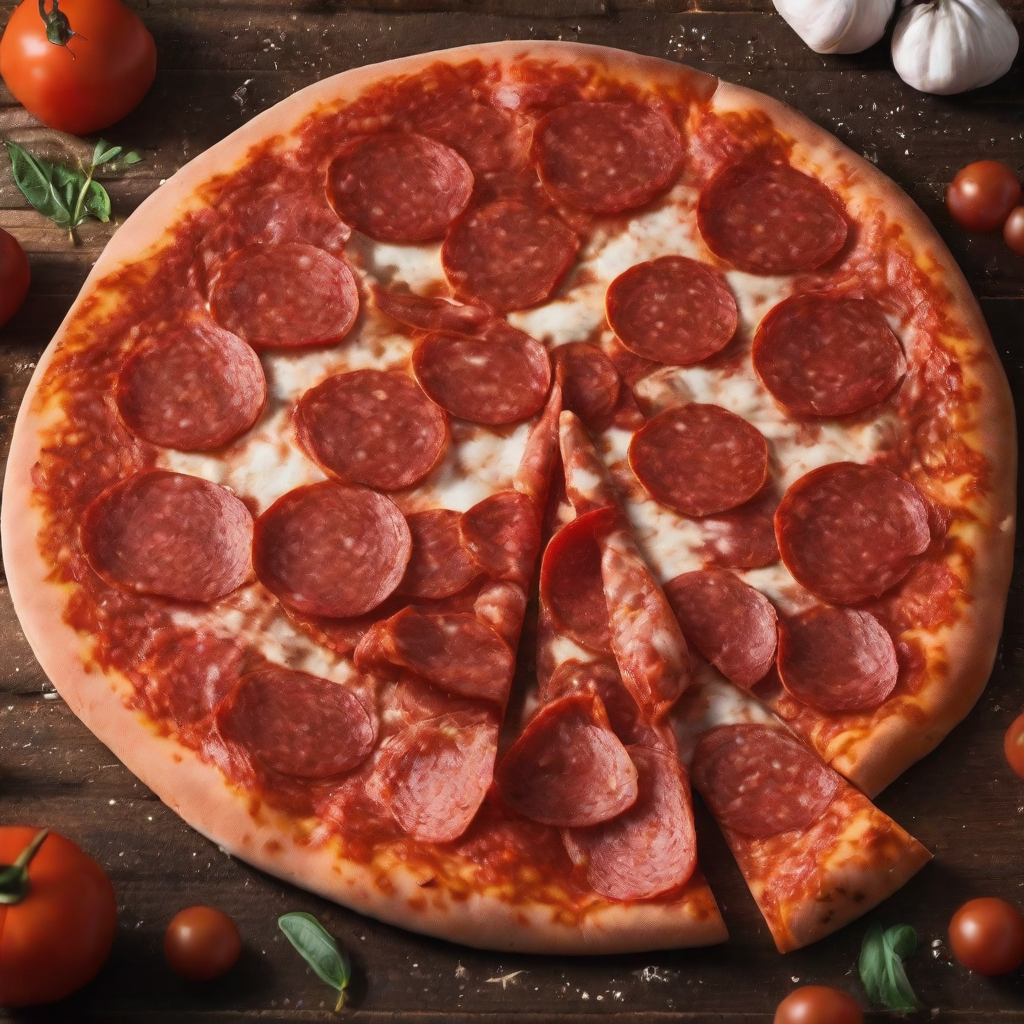Dive into the savory world of pepperoni, where not all slices are created equal, and discover the unique charm of Old World Pepperoni. This distinct variety of America’s beloved pizza topping has a rich history and a flavor profile that sets it apart from the more familiar versions gracing pizza pies across the country. In our feature, “What Is Old World Pepperoni,” we embark on a culinary journey to explore the roots, characteristics, and culinary uses of this traditional meat that has captured the hearts of gourmands and casual diners alike.
Old World Pepperoni is more than just a pizza topping; it’s a testament to age-old meat curing techniques passed down through generations, originating from Europe and making its mark in the modern culinary landscape. Our expertise in the nuances of global cuisines and passion for delving into the stories behind the foods we love positions us perfectly to unravel the mysteries of Old World Pepperoni. We will guide you through its distinct appearance, marked by a smaller diameter and a tendency to curl up at the edges, creating those characteristic charred cups that are coveted by connoisseurs.
This article promises to not only educate but also inspire you to explore the depths of flavor that Old World Pepperoni adds to dishes. Whether you’re a seasoned chef looking to elevate your creations, a home cook curious about different ingredients, or simply someone who appreciates the finer points of pizza toppings, this exploration of Old World Pepperoni is bound to enrich your culinary knowledge and tempt your taste buds.
Join us as we delve into the history, making, and culinary versatility of Old World Pepperoni, shedding light on why this ingredient deserves a place of honor in the pantheon of cherished flavors. Your journey into the heart of authentic pepperoni begins here, promising a blend of educational insights and flavorful discoveries that will pique your curiosity and leave you craving more.
What Is Old World Pepperoni?
Old World Pepperoni refers to a high-quality variety of American pepperoni that is distinct in its use of natural casings, typically sheep intestine, giving it a finer grain and softer texture compared to regular pepperoni that uses man-made casings like collagen. Old World Pepperoni has a dark red color due to paprika and a mix of mild and spicy chilies, providing it with a unique flavor profile. When cooked, Old World Pepperoni curls up at the edges, forming small bowl shapes due to the use of natural casings that react quickly to heat, creating a distinctive cup or bowl shape. This curling effect is a result of thicker slices and the casing material used in Old World Pepperoni.
|
Old World Pepperoni
|
Type | Pizza topping |
| Origin | Italian-inspired | |
| Main Ingredient(s) | Pork, Beef (sometimes) | |
| Casing | Natural (typically sheep intestine) | |
| Spices | Black pepper, mustard seed, garlic, herbs (rosemary, thyme) | |
| Flavor Profile | Savory, slightly spicy, tangy | |
| Texture | Chewy, crispy edges | |
| Appearance | Darker red, larger cups | |
| Cooking Method | Baked on pizza | |
| Popularity | Growing, especially among pizza connoisseurs | |
| Alternatives | American pepperoni, sausage, salami | |
| Healthier Options | Turkey pepperoni, uncured varieties | |
| Interesting Fact | “Salame piccante” in Italian, meaning “spicy salami” |
The Essence and Origins of Old World Pepperoni
The History and Evolution of Pepperoni
Old World Pepperoni evolved from Salamino di Napoli, brought by Italian immigrants settling in America in the late 1800s. While Neapolitan salami used fennel and chilies, immigrants adapted using local pork and spices. Over decades, it developed the wrinkled curled shape and bright red color synonymous with Pepperoni.
Global Variations and Influences
Old World Pepperoni varies across regions. In Italy, Calabria produces spicy versions with chili peperoncino, and Sardinia prefers fennel. American pepperoni balances these flavors. Other adaptations occurred when Italian emigrants settled in Brazil (Pepperoni), and Argentina (Pepperoni Toscano). Local customs always influenced regional variations.
The Evolution of Pepperoni in the U.S.
While pizza existed in Italy for centuries, it was relatively unknown in America until the late 19th century when Italian immigrants brought their culinary traditions over. Early pizzerias reflected the southern Neapolitan style, with simple toppings like cheese, tomatoes, anchovies, and olive oil on thin crusts baked quickly at high heat.
See more : Is Eating Pizza Bad for Cholesterol? Find Out the Truth
Pepperoni emerged as a pizza topping in New York City in the early 1900s, likely an adaptation by Italian butchers working with American ingredients. Pork and beef pepperoni grew popular across pizzerias nationwide by the 1950s and 60s. This thinly sliced sausage evolved distinct qualities from Italian varieties, tailored to pizza use with spices, curing, and smoking methods that intensified flavor and allowed crisping during baking.
Over time, mass production led to many pizzerias switching to widely available commercial pepperoni that lacked the artisanal touches of the old-world style. However, interest in authentic regional foods has brought renewed appreciation for this traditional meat.
Understanding Old World Pepperoni
Artisanal vs. Industrial Production
Artisanal pepperoni relies on natural curing and fermentation over several weeks. This develops richer, more nuanced flavors but is time-consuming. Industrial pepperoni uses artificial additives for speed but lacks complexity. Taste and quality are highly dependent on production methods.
Ingredients and Crafting Techniques
Old World Pepperoni contains pork shoulder or neck, salt, garlic, black pepper, and chili peppers. Higher fat content yields a moist, tender texture after smoking or air-drying. Master butchers hand-mix spices intimately before stuffing them into natural hog casings. Patience and feel craft each link.
Health and Dietary Considerations
As a processed meat, Old World Pepperoni is high in fat and salt. However, its nutrient composition depends on the producer. Nitrates used in curing are under debate for potential links to cancer, though consumption in moderation is not cause for major concern. Those with allergies or sensitivities to its ingredients must be aware.
How Old World Pepperoni Differs from Modern Pepperoni?
Many key differences set old world and modern pepperoni apart:
- Curling – When cooked, old-world pepperoni cups curls up dramatically compared to flat modern varieties. This signature curl comes from using natural casings and the way the meat interacts with spices during fermentation.
- Color – Old world pepperoni is deep red with visible spices, while commercial pepperoni leans towards pink with a homogeneous appearance.
- Flavor – The taste profile of old world pepperoni is more complex, relying on spices like fennel, paprika, anise, and garlic rather than artificial flavorings. It packs a peppery, tangy punch compared to the milder modern versions.
- Texture – Crafted with coarse ground meat rather than emulsions, old world pepperoni has more variable sizing and density. It crisps up yet retains a tender, meaty bite.
Culinary Exploration With Old World Pepperoni
Pairing Suggestions
Pepperoni matches white wines, beers, and aged cheeses due to its bold savoriness. To balance its heat, pair it with sweet fruits like figs. In pizza, let tomato sauce and mozzarella shine through without overpowering them.
Seasonal and Creative Recipes
Beyond pizza, pepperoni inspires adventurous dishes. In winter, toss pepperoni into hearty pasta, stews, or baked rigatoni casserole. Spring calls for pepperoni salad or frittata. During summer, use pepperoni to top homemade flatbread with grilled vegetables and pesto. Autumn begs for inclusion in charcuterie boards with nuts, dried fruits, mustards, and crackers.
Crafting Traditional Old World Pepperoni

Authentic old world pepperoni requires carefully sourcing ingredients and using time-honored artisanal methods. Key aspects include:
- Meats – A coarse grind of pork and beef is used, with the fat content influencing texture and curling.
- Curing – Salting, spices, and bacteria are combined to ferment and cure the meat for concentrated flavor.
- Casing – Natural hog or sheep casings allow cupping when cooked.
- Smoking – Wood smoking for several weeks infuses flavor and aids drying.
- Aging – The pepperoni matures through slow bacterial fermentation, developing signature tanginess.
- Air drying – Further dehydration and enzyme action amplifies the pepperoni’s density and intensity.
Producing authentic old world pepperoni requires patience and skill to achieve the ideal texture and taste.
The Significance of Old World Pepperoni in Italian-American Culture
See more : How much pizza for 10 people? | The ultimate guide
For Italian immigrants, cured meats like pepperoni were a taste of home. Using old world style processing methods helped keep heritage alive. Regions and butchers crafted pepperoni tailored to local tastes with variations in meat blends, spices, casings, and more.
Over time, old world pepperoni became entwined with Italian-American identity and the ubiquity of pizza in the broader American diet. Its legacy reflects the nation’s ethnic fusion and appetite for bold flavors.
For Italian-Americans, chowing down on old world pepperoni evokes nostalgia for family rituals like weekly pizza nights. Seeking authentic pepperoni also enables engagement with ancestral foodways. The abiding popularity of this specialty meat is a testament to the lasting influence of Italian food in America.
Regional Styles of Old World Pepperoni
While it has common characteristics, geographical differences and local specialization lead to variations:
- New York – Dense and compact meat for cupping when baked on pizza.
- New England – Lighter-colored and flavored pepperoni with pronounced fermentation.
- Pennsylvania – Smokier pepperoni in flavor and appearance with black pepper zing.
- Ohio River Valley – Thickcut pepperoni greasier than other regions.
- Chicago/Midwest – More seasoning than East Coast varieties with an extra garlic punch.
- California – Grainier texture and use of chili pepper.
Understanding the regional nuances allows choosing a pepperoni that aligns with personal taste preferences.
Practical Insights of Old World Pepperoni for Enthusiasts

Storing and Preserving Freshness
Keep pepperoni wrapped in the fridge for 1-2 months or freeze for up to 6 months. Thaw overnight in the fridge. Its high salt and smoke resistance pantry molds for weeks at cool room temp if tightly sealed, though quality degrades faster than refrigerated.
Label Reading and Understanding
Look for production methods, percentage meat content, and curing processes. “Natural” means no artificial nitrates. A percentage higher indicates more meat, herbs, and salt rather than fat or water. “Dry cured” takes 4+ weeks while “soft salami” is quicker.
Where to Buy and What to Look For
Seek specialty butchers and high-end markets. Artisan versions are handcrafted in small batches, contain higher meat ratios, and have aged 2+ weeks. Look for minimal ingredients, and snug casings fully encasing soft yet firm links. Price may be higher but quality and nutrition vastly surpass industrial brands.
Beyond the Old World Pepperoni Pizza
Exploring Other Uses
Thinly slice atop salads, bruschetta, and antipasto platters. Dice into pastas, risottos or homemade pizza rolls. Toss with veggies to roast for a harvest medley. Pan-fry crispy chunks as a savory snack. Crumble onto homemade pizzas, calzones,stromboli or quiche.
Pairing with Beverages
Pepperoni loves red wine! Medium-bodied reds like Chianti, Barbera, or Valpolicella allow its richness to shine through. For beers, malty ambers or dry stouts complement its subtle spice. A crisp Pilsner or Kölsch cuts through the fat. Add a drizzle of hot honey for pairing soft drinks, iced teas, or lemonades.


Ronald B Gamrot is the owner of Silverking Brewery, one of the most successful craft breweries in North America. He started the business from scratch in his garage, and it has since grown into a multimillion-dollar operation. Ronald is passionate about brewing delicious beer and providing top-notch customer service. He is a respected member of the brewing community and often speaks at industry events.








Nobody ever seems to know how to make it right. It needs a buttload of old world pepperonis, and the pizza has to have no top crust. The cheese and pepperonis going from end to end.
The pepperonis taste like normal pepperonis aside from the stupid crisp edges
Needs more pepperonis and that’s the wrong type of crust. So it’s a good pizza in terms of overall pizza but not what it’s supposed to be.
Thanks for taking the time to comment.
Thank you for sharing your thoughts! It’s always great to hear different perspectives.
I’m grateful for your input. It adds a valuable layer to the discussion.